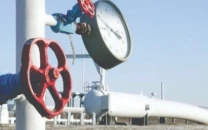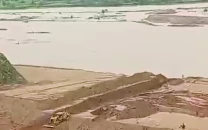Terrorists striking at will
.

Two big events, triggered by two different militant groups within a space of 24 hours, convey an extremely disturbing and scary security situation.
On January 8, a band of at least 80 militants stormed the Zehri bazaar (Khuzdar) without facing any resistance from the Levies force stationed in the area. The militants ransacked government buildings, robbed a private bank and took local Levies personnel hostage. Other targets of arson included the Levies station, municipal committee offices and Nadra office.
The raid lasted for eight hours, prompting the provincial government to order an enquiry into the brazen incident.
The outlawed Baloch Liberation Army (BLA) claimed responsibility for the attack that officials said did not cause casualties. This incident reminisced the coordinated attacks in August 2024 that rocked the towns of Mastung, Kalat, Pasni, Panjgur, Turbat and Suntsar, targeting both civilians as well as Levies and police stations, resulting in numerous casualties.
On January 9, TTP militants abducted at least 16 workers of a state-run mining company in the Lakki Marwat district of Khyber-Pakhtunkhwa province.
Militants ambushed the minibus that was carrying the workers to the mining project site in the Qaboolkhel area. They set the vehicle on fire before fleeing with the captives.
The TTP claimed responsibility for the kidnapping and released a video featuring the kidnapped workers, some of whom were seen urging authorities to ensure their safe release by complying with the militants' demands, but did not elaborate further.
Eight of the abducted workers were rescued by security forces in an operation. Three of them were critically injured during the rescue action. Efforts for the release of the other eight were underway while these lines were being written, according to the Lakki Marwat police.
This brazen incident also underlines the wave of militancy that is currently sweeping the southern K-P districts such as Lakki Marwat, Bannu, Khyber, Waziristan and Bajaur. These regions, bordering Afghanistan or close to it, have seen an unusual spike in TTP violence during the last year. Civil and military security forces and government officials have mostly been the target of these attacks.
Both incidents raise critical questions on the state of preparedness and the security forces' response to such situations.
Firstly, the delayed response to terrorist violence. Those responsible must explain how terrorists were able to commandeer unchallenged for eight hours an area (Khuzdar) which is supposed to be well-prepared for such contingencies and has a number of pro-federation leaders? That non-state actors can take an entire town hostage for several hours is quite mind-boggling.
The BLF apparently did it to register its capability to strike at will and at a time of its choice, without any consequences - at least thus far. Viewed against similar exercises in the past, the enquiry ordered by the provincial government is unlikely to entail much.
Secondly, whether any SOPs are being followed. The ambush and the abduction of the mine project workers in Lakki Marwat points to deviation from, or the absence of, any SOPs for officials and workers linked to critical operations. Should this not be both alarming and embarrassing for the security forces in general?
Thirdly, have the civil, military security forces adapted to the fast-evolving nature of terrorism through proxies that are well-trained, well-equipped and well-fed and have ratcheted up violence like never before in the last decade or so?
Fourth, counter-terrorism response is not just about kinetic strikes and intelligence-based operations that we keep hearing about. These are largely reactive measures, hardly enough to put out the fire. Insurgency and extremist ideologies - often at variance with the state - are like smoldering fires. They need to be extinguished entirely. That comes through indiscriminate enforcement of Rule of Law and with no expedience in favour of a particular group.
Fifth, the state security apparatus will have to divorce the old border management approaches that coopted warlords and, at times, even criminal cartels for keeping the border with Afghanistan safer. Hafiz Gul Bahadur, Maulvi Sadiq Noor and Mulla Nazir are some of those whom the institutions appeased and cut deals with for temporal facilitation in the border regions.
Sixth, without putting an end to short-term expedience (such as getting support of religio-political groups like JUI-F or Jamaat-e-Islami for 26th constitutional amendment, for example), it will be difficult to weed out those elements within the religio-political landscape who actually quietly provide shoulder and shelter to terrorist groups. The same goes for the Afghan friends such as the Haqqanis, who may be friends but at the same time may be a big shelter in Afghanistan for the TTP terrorists that Pakistan is hunting and is wary of.
Lastly, the biggest complication that feeds terrorism - the proxy war - are the internal fault-lines such as sectarian and ethnic divides, nationalist-sub-nationalist centrifugal movements and radical religio-political groups that serve as social shelter for terrorist groups. This proxy war - with internal feeders - apparently also feeds off external factors.
Should we assume that Pakistan will have to live with this state of insecurity for years to come because of these complicating internal and external factors? Or will it be able to move forward while devising a much more smarter and technology-driven surveillance mechanism?














COMMENTS
Comments are moderated and generally will be posted if they are on-topic and not abusive.
For more information, please see our Comments FAQ